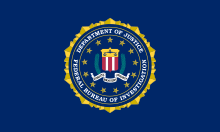Index crime
| Federal Bureau of Investigation | |||||||||||||||||||||||||||||||||||||||||||||||||||||||||||
|---|---|---|---|---|---|---|---|---|---|---|---|---|---|---|---|---|---|---|---|---|---|---|---|---|---|---|---|---|---|---|---|---|---|---|---|---|---|---|---|---|---|---|---|---|---|---|---|---|---|---|---|---|---|---|---|---|---|---|---|
| Common name | Federal Bureau of Investigation | ||||||||||||||||||||||||||||||||||||||||||||||||||||||||||
| Abbreviation | FBI | ||||||||||||||||||||||||||||||||||||||||||||||||||||||||||

|
|||||||||||||||||||||||||||||||||||||||||||||||||||||||||||
|
|||||||||||||||||||||||||||||||||||||||||||||||||||||||||||
| Notables | |
|---|---|
| People |
|
| Significant Operations | |
The Uniform Crime Reports (UCR) compiles official data on crime in the United States, published by the Federal Bureau of Investigation (FBI). UCR is "a nationwide, cooperative statistical effort of nearly 18,000 city, university and college, county, state, tribal, and federal law enforcement agencies voluntarily reporting data on crimes brought to their attention".
Crime statistics are compiled from UCR data and published annually by the FBI in the Crime in the United States series.
The FBI does not collect the data itself. Rather, law enforcement agencies across the United States provide the data to the FBI, which then compiles the Reports.
The Uniform Crime Reports program began in 1930, and since then has become an important source of crime information for law enforcement, policymakers, scholars, and the media. The UCR Program consists of four parts:
The FBI publishes annual data from these collections in Crime in the United States, Law Enforcement Officers Killed and Assaulted, and Hate Crime Statistics.
The UCR Program was based upon work by the International Association of Chiefs of Police (IACP) and the Social Science Research Council (SSRC) throughout the 1920s to create a uniform national set of crime statistics, reliable for analysis. In 1927, the IACP created the Committee on Uniform Crime Reporting to determine statistics for national comparisons. The committee determined seven crimes fundamental to comparing crime rates: murder and non-negligent manslaughter, forcible rape, burglary, aggravated assault, larceny and motor vehicle theft (the eighth, arson, was added under a congressional directive in 1979). The early program was managed by the IACP, prior to FBI involvement, done through a monthly report. The first report in January 1930 reported data from 400 cities throughout 43 states, covering more than 20 million individuals, approximately twenty percent of the total U.S. population.
On June 11, 1930, through IACP lobbying, the United States Congress passed legislation enacting 28 U.S.C. § 534, which granted the office of the Attorney General the ability to "acquire, collect, classify, and preserve identification, criminal identification, crime, and other records" with the ability to appoint officials to oversee this duty, including the subordinate members of the Bureau of Investigation. The Attorney General, in turn, designated the FBI to serve as the national clearinghouse for the data collected, and the FBI assumed responsibility for managing the UCR Program in September 1930. The July 1930 issue of the IACP crime report announced the FBI’s takeover of the program. While the IACP discontinued oversight of the program, they continued to advise the FBI to better the UCR.
...
Wikipedia


